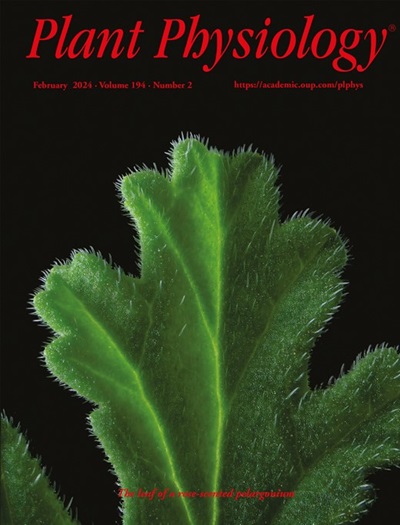百香果外源基因表达及病毒诱导基因沉默的端粒花叶病毒载体
IF 6.9
1区 生物学
Q1 PLANT SCIENCES
引用次数: 0
摘要
百香果(Passiflora edulis)是一种多年生木本热带藤本植物。它生产可食用的圆形到椭圆形的果实,因其独特的香气和味道以及丰富的抗氧化剂、维生素和矿物质而备受青睐。然而,由于缺乏简单有效的遗传工具,百香果的功能基因组学研究很少。在这里,我们开发了基于端粒花叶病毒(TelMV)的病毒介导的蛋白过表达(VOX)和病毒诱导的基因沉默(VIGS)载体,TelMV是一种感染世界各地的百香果植物的新兴多病毒。该载体被命名为pTelMV-GW,包含网关兼容重组位点,用于快速基因克隆。利用该载体,我们在百香果中实现了绿色荧光蛋白(GFP)和细菌植物烯合成酶(CrtB)两种异种蛋白的系统稳定表达。此外,含有不同GFP片段的pTelMV-GW也能诱导转GFP的烟类植物的系统性基因沉默。此外,我们还利用该载体触发了百香果植物中植物烯去饱和酶(PDS)和镁螯合酶亚基I (ChlI)的沉默。使用轻度TelMV菌株编码突变的辅助成分蛋白酶(HC-Pro),使RNA沉默抑制活性受损,从而增强了基于TelMV的VIGS。该升级载体(pTelMV-R181K-GW)含有PDS或ChlI片段,可诱导百香果植株出现明显的光漂白或泛黄表型。总的来说,我们的工作提出了一套用于百香果植物的VIGS和VOX载体,这是鉴定提高百香果产量和质量的重要园艺基因的关键一步。本文章由计算机程序翻译,如有差异,请以英文原文为准。
A telosma mosaic virus-based vector for foreign gene expression and virus-induced gene silencing in passion fruit
Passion fruit (Passiflora edulis) is a perennial, woody, tropical vine. It produces edible round to oval fruit that is highly favored for its unique aroma and taste, as well as its richness in antioxidants, vitamins, and minerals. However, functional genomics studies of passion fruit are scarce, as simple and efficient genetic tools are lacking for this species. Here, we developed virus-mediated protein overexpression (VOX) and virus-induced gene silencing (VIGS) vectors based on the telosma mosaic virus (TelMV), an emerging potyvirus that infects passion fruit plants worldwide. This vector, designated pTelMV-GW, incorporates Gateway-compatible recombination sites for rapid gene cloning. Using this vector, we achieved systemic stable expression of two heterologous proteins in passion fruit: green fluorescent protein (GFP) and bacterial phytoene synthase (CrtB). Additionally, pTelMV-GW containing different GFP fragments also induced systemic gene silencing in GFP-transgenic Nicotiana benthamiana plants. Furthermore, we used this vector to trigger phytoene desaturase (PDS) and magnesium chelatase subunit I (ChlI) silencing in passion fruit plants. The TelMV-based VIGS was enhanced using a mild TelMV strain encoding a mutated helper-component proteinase (HC-Pro) with impaired RNA silencing suppressor activity. This upgraded vector (pTelMV-R181K-GW), containing PDS or ChlI fragments, induced clear photobleaching or yellowing phenotypes in passion fruit plants. Overall, our work presents a set of VIGS and VOX vectors for use in passion fruit plants, a crucial step towards identifying horticulturally important genes for improving passion fruit production and quality.
求助全文
通过发布文献求助,成功后即可免费获取论文全文。
去求助
来源期刊

Plant Physiology
生物-植物科学
CiteScore
12.20
自引率
5.40%
发文量
535
审稿时长
2.3 months
期刊介绍:
Plant Physiology® is a distinguished and highly respected journal with a rich history dating back to its establishment in 1926. It stands as a leading international publication in the field of plant biology, covering a comprehensive range of topics from the molecular and structural aspects of plant life to systems biology and ecophysiology. Recognized as the most highly cited journal in plant sciences, Plant Physiology® is a testament to its commitment to excellence and the dissemination of groundbreaking research.
As the official publication of the American Society of Plant Biologists, Plant Physiology® upholds rigorous peer-review standards, ensuring that the scientific community receives the highest quality research. The journal releases 12 issues annually, providing a steady stream of new findings and insights to its readership.
 求助内容:
求助内容: 应助结果提醒方式:
应助结果提醒方式:


